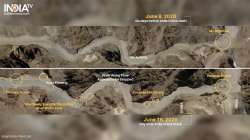Days after the deadly Indo-China clash in the Galwan valley in the eastern Ladakh region, it seems Beijing is trying to change the geography of the region, by building a dam on the Galwan river, moving machinery, convoy, satellite images suggest. The satellite images captured by Earth-imaging company Planet Labs reveal how China was altering the landscape of the Galwan valley through widening tracks, moving earth and making river crossings.
Images from the Line of Actual Control (LAC) in Ladakh's Galwan river valley show Chinese machinery, trucks and convoy along the bald mountains. These images prove how China breached the international treaty of no activity near the border. The images, shot on June 16 (Tuesday), a day after soldiers engaged in hand-to-hand combat in the freezing Galwan Valley, show an increase in activity from a week earlier, Reuters report says.
Satellite images taken between June 9 (before Indo-China clash) and June 16 (after Indo-China clash) show China trying to disrupt geography in the Galwan Valley, in eastern Ladakh by possibly building a dam as river flow appears to be stopped, presence of trucks, heavy machinery is also seen.
20 Indian soldiers were martyred in the "violent clash" that broke out after the Indian Army approached China to remove the illegal tent they had established at one of its patrolling points.
But more than anything else, the fact that China is building a road and in fact building a dam on river Galwan. The news exposes China's nefarious plans to alter the geography of the Galwan valley.
Satellite images reveal China damming Galwan river, was constructing road after a deadly clash at the LAC.
Commenting on China's latest attempts, Director of the East Asia Nonproliferation Program at California’s Middlebury Institute of International Studies, Jeffrey Lewis said, "Looking at it in Planet, it looks like China is constructing roads in the valley and possibly damming the river," Reuters quoted.
Satellite images also suggest the presence of heavy troops vehicles on both sides of the LAC, the majority being on the Chinese side. Images also show Chinese earth movers trying to stop the flow of the river in the Galwan valley.
Meanwhile, the Indian Air Force has also swung into action by moving troops using Chinook heavy-lift helicopters.
China's official reaction
China and India have agreed to deal with the "serious matter" caused by the conflict at the Galwan Valley in a "just manner" and both sides are in communication and coordination through diplomatic and military channels to de-escalate the tensions as soon as possible, China's Foreign Ministry spokesman Zhao Lijian said.
Deadlock points: Pangong Tso, Galwan Valley, Demchok and Daulat Beg Oldie in eastern Ladakh
A large number of Indian and Chinese troops have been engaged in an eyeball-to-eyeball situation in Galwan Valley and certain other areas of eastern Ladakh for the last five weeks, including in Pangong Tso, Galwan Valley, Demchok and Daulat Beg Oldie in eastern Ladakh.
Monday's face-off was the biggest confrontation between the two militaries after their 1967 clashes in Nathu La when India lost around 80 soldiers while over 300 Chinese army personnel were killed in the face-off.
The Indian Army has been fiercely objecting to the Chinese transgressions and demanded their immediate withdrawal for the restoration of peace and tranquillity in the area. Both sides held a series of talks in the last few days to resolve the row.
China provocative transgression in the Galwan valley region which led to the deadly clashes between the two countries is building an anti-China narrative with demands such as boycott China products being witnessed in the country.
(Agency Inputs)
Latest India News
